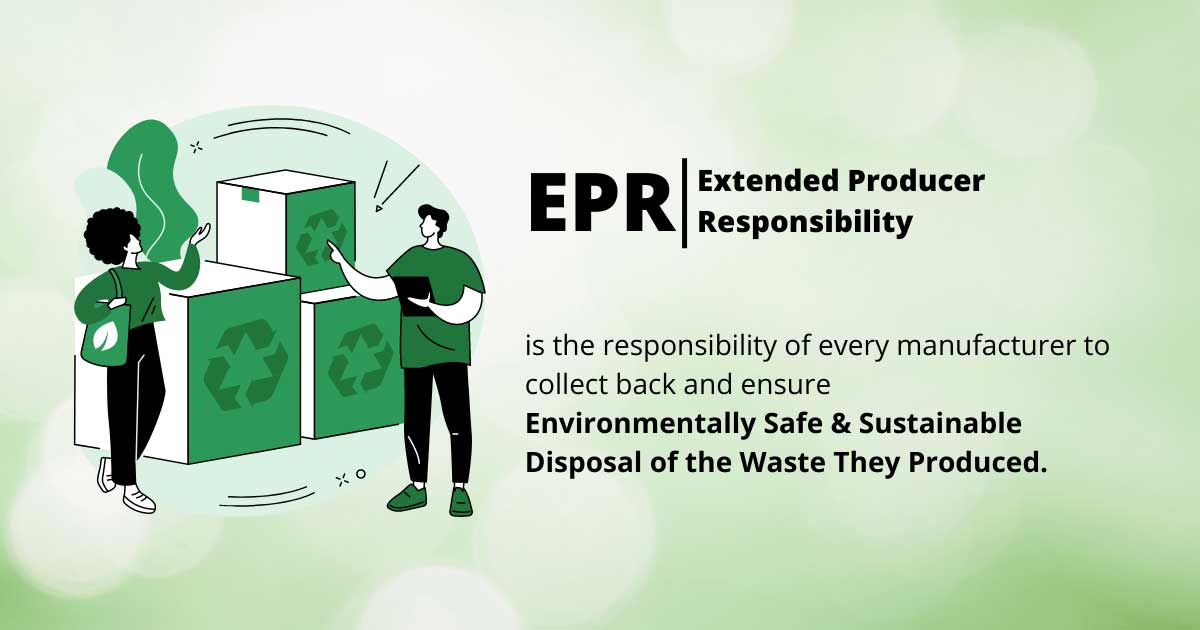Extended Producer Responsibility and How it Relates to E-waste
Today’s blog discusses extended producer responsibility (EPR) and how it relates to e-waste. Extended producer responsibility refers to a policy-primarily based approach that aims to vest potential waste generators with the legal responsibility of dealing with pre-consumer and post-consumer waste. EPR is a massive step towards a circular economy and possibly the only viable solution for the effective management of plastic and digital wastes.
Who Extended Producer Responsibility Applies to?

If you produce, import, or manufacture plastic for packaging your products, you come under the Plastic Waste Management (PWM) Rules, 2016.
You are governed under E-waste Management Rules, 2016, if you produce, manufacture, or import electronic products.
Authorization for EPR in E-Waste Management
Faced with the growing amount of waste in India, the government decided to review its policy options. It found that a viable alternative could be to shift responsibility for the post-consumer phase of certain items to manufacturers. Manufacturers are placed under the extended producer responsibility (EPR) policy approach with significant financial and physical responsibility for the handling or disposing of post-consumer items. Assigning such responsibility could provide incentives to reduce e-waste at the source, encourage eco-friendly product design, and support public recycling and e-waste management goals. The OECD (Organization for Economic Cooperation and Development) is expanding the EPR to include other products, product groups, and waste streams such as household appliances and electronics.
What are the roles and responsibilities of EPR concerning e-waste?
- Manufacturers are responsible for the collection and disposal of the waste of elements with the same code of electrical and electronic equipment.
- Manufacturers are creating a framework to channel e-waste collected from dealers and authorized service centers and waste collected from end-of-life items.
- Hazardous compounds such as mercury and lead require pre-treatment, and the manufacturer is responsible for disposal at treatment, storage, and disposal facilities.
- Manufacturers should take care of the collection of e-waste such as electrical and electronic equipment that was previously placed on the market through a dealer, collection point, producer responsibility organization, buy-back agreement, exchange or deposit refund system.
- Manufacturers must organize an awareness program and raise awareness through media, advertisements, publications, posters, or other means of communication and the product user documentation accompanying the device.
- Manufacturers must provide contact details such as address, email ID, toll-free phone number, or helpline number to consumers or wholesale users through their website.
What are the benefits of EPR authorization when approving e-waste?
Extended producer responsibility is often discussed as a technique to counteract planned obsolescence, as it financially incentivizes manufacturers to develop recyclable products and extend the lifespan of their products.
In addition to tackling planned obsolescence, governments can relieve themselves of the financial pressure to pay for and manage waste by shifting some cost burdens to the producer.
One of the major benefits of extended producer responsibility is that it becomes more effective as coercion is applied to the countries that export e-waste. The e-waste regulation forces infrastructure to deal with the garbage or find new ways for manufacturers to produce goods. As more countries adopt this policy, it becomes harder for others to overlook the challenges.
For example, the lack of infrastructure for e-waste recycling in the United States was made possible by the ability to export and the negligence of manufacturers. The burden of this growing e-waste dump is forcing countries to build up their infrastructure and compelling local and federal governments to impose more robust controls on companies.
Conclusion
Several environmental concerns arise from the manufacture and disposal of electrical and electronic equipment. The environmental impact of its production is usually high. Due to the ever-increasing amounts and diverse nature of e-waste, it is also difficult to dispose of. It is disposed of in landfills that have limited space in the long term or recycled raw. E-waste contains significant amounts of toxic components that can harm public health and the environment. Extended Producer Responsibility is proving to be a useful policy tool to address these issues. Applying this tool will help manage this growing e-waste and encourage manufacturers or manufacturers to redesign their products.
GreenTek Reman is APAC’s first R2v3 certified ITAD and e-waste management company. With a decade of experience in e-waste management, and assist enterprises in meeting their EPR responsibilities.


